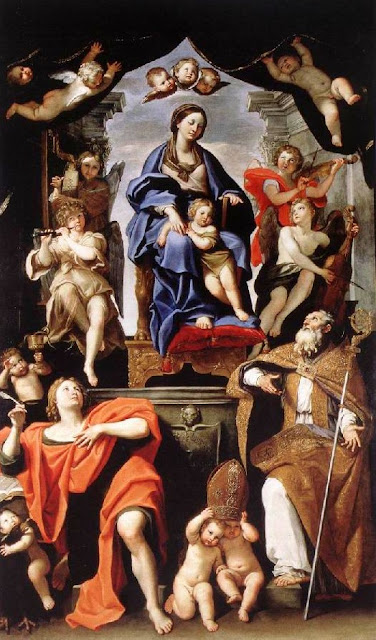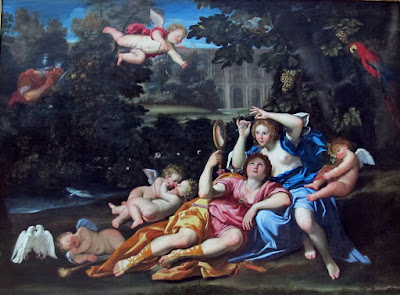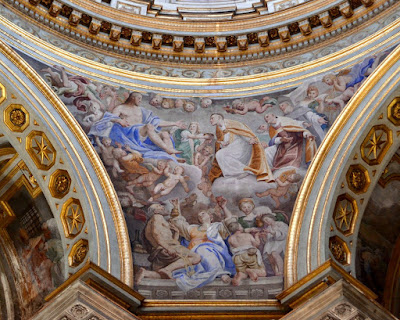 |
| Domenichino Head of St John the Baptist ca. 1630 oil on canvas Real Academia de Bellas Artes de San Fernando, Madrid |
 |
| Domenichino Landscape with Boats on a Lake ca. 1610 oil on canvas Pinacoteca Nazionale di Bologna |
 |
| Domenichino Landscape with Tobias and the Angel ca. 1610-13 oil on copper National Gallery, London |
 |
| Domenichino Landscape with Abraham leading Isaac to sacrifice 1602 oil on copper Kimbell Art Museum, Fort Worth, Texas |
 |
| Domenichino Cumaean Sibyl 1616-17 oil on canvas Galleria Borghese, Rome |
 |
| Domenichino Timoclea before Alexander the Great ca. 1615 oil on canvas Musée du Louvre |
 |
| Domenichino Giulia Farnese as Virgin charming Unicorn in a Landscape ca. 1602 fresco Palazzo Farnese, Rome |
 |
| Domenichino Martyrdom of St Peter of Verona (detail) ca. 1619-21 oil on canvas Pinacoteca Nazionale di Bologna |
 |
| Domenichino Martyrdom of St Andrew ca. 1630 fresco Basilica di Sant'Andrea della Valle, Rome |
 |
| Domenichino Martyrdom of St Agnes ca. 1619-25 oil on canvas Pinacoteca Nazionale di Bologna |
 |
| Domenichino Martyrdom of St Agnes (detail) ca. 1619-25 oil on canvas Pinacoteca Nazionale di Bologna |
 |
| Domenichino Martyrdom of St Agnes (detail) ca. 1619-25 oil on canvas Pinacoteca Nazionale di Bologna |
 |
| Domenichino Virgin and Child enthroned with St John the Evangelist and St Petronius 1629 oil on canvas Palazzo Barberini, Rome |
 |
| Domenichino Rinaldo and Armida (scene from Gerusalemme Liberata by Torquato Tasso) ca. 1617-21 oil on canvas Musée du Louvre |
 |
| Domenichino Christ receiving Saints in Heaven ca. 1631-34 pendentive fresco Cattedrale di San Gennaro, Naples |
"One of the Bolognese pupils of the Carracci, Domenichino became, after Annibale Carracci's death in 1609, a leading painter in Rome. His frescoes [of that period] are foremost examples of the style known as Early Baroque Classicism, which was influenced by Raphael and the Antique. Poussin was to be deeply impressed with these works in the 1620s, and he was also influenced by Domenichino's small landscape paintings, as was Claude [Lorrain]. During 1622-28 Domenichino painted the choir and pendentives of S. Andrea della Valle, while his arch-rival, [Giovanni] Lanfranco received the commission for the dome. Responding to the demands of scale and location as much as to Lanfranco's illusionism (derived from Correggio's Parma domes) Domenichino here modified his former manner. The new tendency to Baroque was further accentuated in the pendentives and dome of the Chapel of S. Gennaro of the Cathedral in Naples, for which he was commissioned in 1630."
– Erika Langmuir and Norbert Lynton, Yale Dictionary of Art and Artists (2000)
"Together with his fellow northern Italian painters, Guido Reni, Francesco Albani, Giovanni Lanfranco and Guercino, Domenico Zampieri – known after his small stature as Domenichino – is one of the towering figures of seventeenth-century painting. Indeed, until the mid-nineteenth century, his reputation stood second only to that of Raphael, and his influence far outstripped that of Caravaggio, with whose work his own was often contrasted. . . . Domenichino was a brilliant draftsman and always began his compositions with careful studies from posed models. But he believed firmly that nature was only the starting point for art, which needed to be transformed into a higher realm: one that would not be subject to the imperfections and transience of everyday life. One of his guideposts was the sculpture of antiquity, which he studied for its mastery of proportions and the idealization of the human form as well as the vigorous gestures it incorporated. His finely constructed yet atmospheric landscapes laid the groundwork for the ideal, classical landscapes of Claude Lorrain. Their point was to create a mood, not to transcribe a casual view."
– excerpted from an essay by Keith Christiansen on the Heilbrunn Timeline of Art History at the Metropolitan Museum, New York